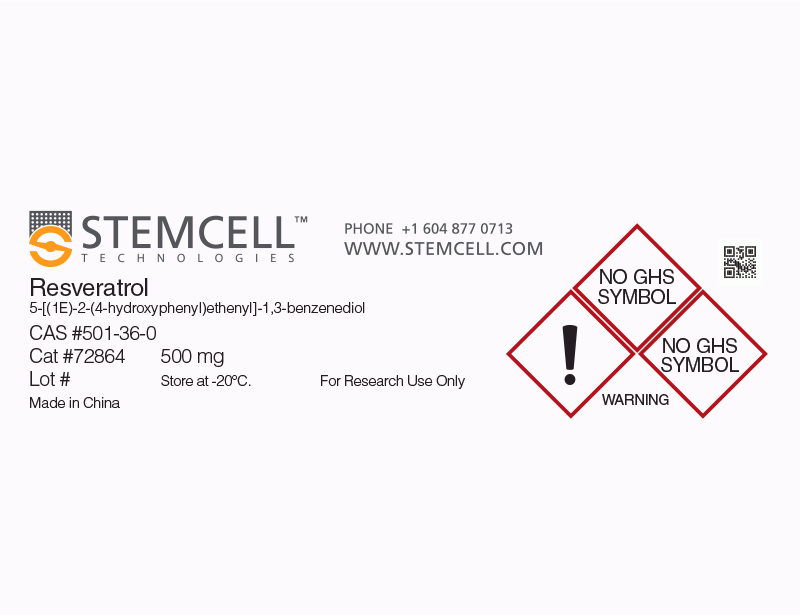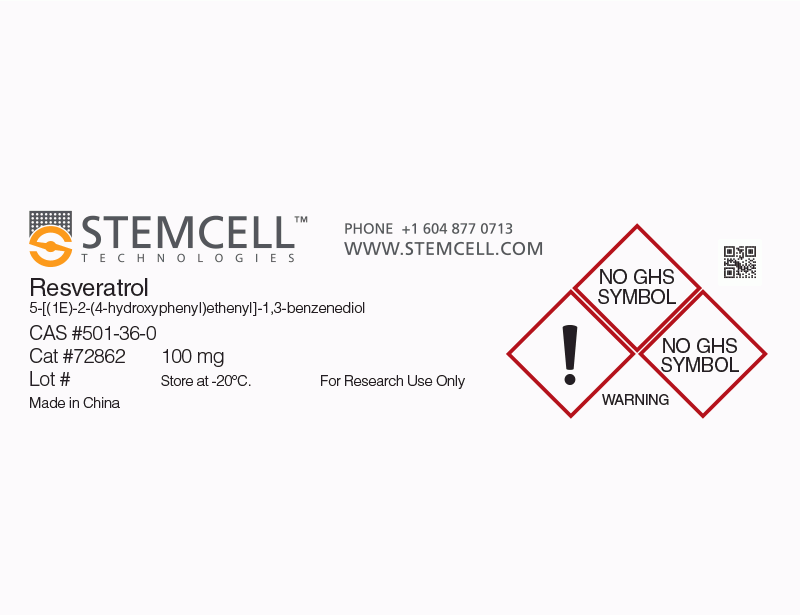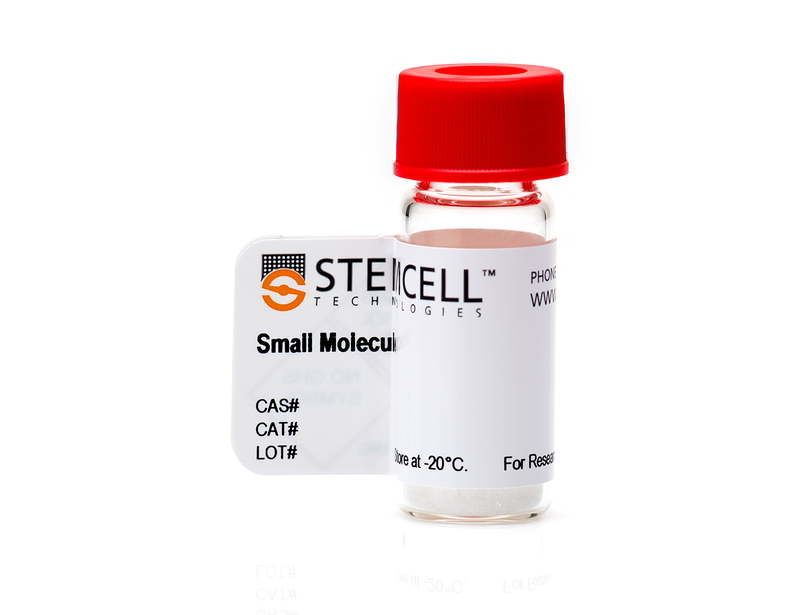概要
Resveratrol is a potent phenolic antioxidant found in grapes and red wine that also has antiproliferative and anti-inflammatory activity (Rotondo et al.). Resveratrol is also a selective inhibitor of cyclooxygenase-1 (COX-1; Jang) with an ED₅₀ value of 15 μM, respectively.
MAINTENANCE AND SELF-RENEWAL
· Inhibits differentiation of pig preadipocytes into adipocytes (Bai et al.).
· Promotes self-renewal of human mesenchymal stem cells (Peltz et al.).
DIFFERENTIATION
· Induces osteogenic differentiation in human bone marrow-derived mesenchymal stem cell cultures (Boissy et al.; Dai et al.; Peltz et al.).
· Induces osteoblast differentiation while blocking adipocyte development in mouse mesenchymal stem cells and cultured primary rat bone marrow cells (Bäckesjö et al.).
MAINTENANCE AND SELF-RENEWAL
· Inhibits differentiation of pig preadipocytes into adipocytes (Bai et al.).
· Promotes self-renewal of human mesenchymal stem cells (Peltz et al.).
DIFFERENTIATION
· Induces osteogenic differentiation in human bone marrow-derived mesenchymal stem cell cultures (Boissy et al.; Dai et al.; Peltz et al.).
· Induces osteoblast differentiation while blocking adipocyte development in mouse mesenchymal stem cells and cultured primary rat bone marrow cells (Bäckesjö et al.).
技术资料
| Document Type | 产品名称 | Catalog # | Lot # | 语言 |
|---|---|---|---|---|
| Product Information Sheet | Resveratrol | 72862, 72864 | All | English |
| Safety Data Sheet | Resveratrol | 72862, 72864 | All | English |
数据及文献
Publications (7)
PloS one 2012 JAN
Resveratrol exerts dosage and duration dependent effect on human mesenchymal stem cell development.
Abstract
Abstract
Studies in the past have illuminated the potential benefit of resveratrol as an anticancer (pro-apoptosis) and life-extending (pro-survival) compound. However, these two different effects were observed at different concentration ranges. Studies of resveratrol in a wide range of concentrations on the same cell type are lacking, which is necessary to comprehend its diverse and sometimes contradictory cellular effects. In this study, we examined the effects of resveratrol on cell self-renewal and differentiation of human mesenchymal stem cells (hMSCs), a type of adult stem cells that reside in a number of tissues, at concentrations ranging from 0.1 to 10 µM after both short- and long-term exposure. Our results reveal that at 0.1 µM, resveratrol promotes cell self-renewal by inhibiting cellular senescence, whereas at 5 µM or above, resveratrol inhibits cell self-renewal by increasing senescence rate, cell doubling time and S-phase cell cycle arrest. At 1 µM, its effect on cell self-renewal is minimal but after long-term exposure it exerts an inhibitory effect, accompanied with increased senescence rate. At all concentrations, resveratrol promotes osteogenic differentiation in a dosage dependent manner, which is offset by its inhibitory effect on cell self-renewal at high concentrations. On the contrary, resveratrol suppresses adipogenic differentiation during short-term exposure but promotes this process after long-term exposure. Our study implicates that resveratrol is the most beneficial to stem cell development at 0.1 µM and caution should be taken in applying resveratrol as an anticancer therapeutic agent or nutraceutical supplement due to its dosage dependent effect on hMSCs.
Cells, tissues, organs 2009 JAN
Activation of Sirt1 decreases adipocyte formation during osteoblast differentiation of mesenchymal stem cells.
Abstract
Abstract
Mesenchymal stem cells (MSC) can differentiate into osteoblasts, adipocytes, chondrocytes and myoblasts. It has been suggested that a reciprocal relationship exists between the differentiation of MSC into osteoblasts and adipocytes. Peroxisome proliferator-activated receptor gamma2 (PPARgamma2) is a key element for the differentiation into adipocytes. Activation of the nuclear protein deacetylase Sirt1 has recently been shown to decrease adipocyte development from preadipocytes via inhibition of PPARgamma2. In vitro, MSC differentiate to osteoblasts when exposed to bone-inducing medium. However, adipocytes are also developed. In the present study we have targeted Sirt1 to control adipocyte development during differentiation of MSC into osteoblasts. The finding that resveratrol and isonicotinamide markedly inhibited adipocyte and promoted osteoblast differentiation demonstrates an interesting alternative to PPARgamma antagonists. These results are important for the evolving field of cell-based tissue engineering, but may also be relevant in the search for new treatments of osteoporosis.
Molecular and cellular biochemistry 2008 JAN
Modulation of Sirt1 by resveratrol and nicotinamide alters proliferation and differentiation of pig preadipocytes.
Abstract
Abstract
Sirt1, a NAD(+)-dependent histone deacetylase, may regulate senescence, metabolism, and apoptosis. In this study, primary pig preadipocytes were cultured in DMEM/F12 medium containing 10% fetal bovine serum (FBS) with or without reagents affecting Sirt1 activity. The adipocyte differentiation process was visualized by light microscopy after Oil red O staining. Proliferation and differentiation of preadipocytes was measured using methylthiazolyldiphenyl-tetrazolium bromide (MTT) and Oil red O extraction. Expression of Sirt1, FoxO1, and adipocyte specific genes was detected with semi-quantitive RT-PCR. The results showed that Sirt1 mRNA was widely expressed in various pig tissues from different developmental stages. Sirt1 mRNA was expressed throughout the entire differentiation process of pig preadipocytes. Resveratrol significantly increased Sirt1 mRNA expression, but decreased the expression of FoxO1 and adipocyte marker gene PPARgamma2. Resveratrol significantly inhibited pig preadipocyte proliferation and differentiation. Nicotinamide decreased the expression of Sirt1 mRNA, but increased the expression of FoxO1 and adipocyte specific genes. Nicotinamide greatly stimulated the proliferation and differentiation of pig preadipocytes. In conclusion, these results indicate that Sirt1 may modulate the proliferation and differentiation of pig preadipocytes. Sirt1 may down-regulate pig preadipocytes proliferation and differentiation through repression of adipocyte genes or FoxO1.
Phytomedicine : international journal of phytotherapy and phytopharmacology 2007 DEC
Resveratrol enhances proliferation and osteoblastic differentiation in human mesenchymal stem cells via ER-dependent ERK1/2 activation.
Abstract
Abstract
In the present study, we investigated the in vitro effect of resveratrol (RSVL), a polyphenolic phytoestrogen, on cell proliferation and osteoblastic maturation in human bone marrow-derived mesenchymal stem cell (HBMSC) cultures. RSVL (10(-8)-10(-5) M) increased cell growth dose-dependently, as measured by [(3)H]-thymidine incorporation, and stimulated osteoblastic maturation as assessed by alkaline phosphatase (ALP) activity, calcium deposition into the extracellular matrix, and the expression of osteoblastic markers such as RUNX2/CBFA1, Osterix and Osteocalcin in HBMSCs cell cultures. Further studies found that RSVL (10(-6)M) resulted in a rapid activation of both extracellular signal-regulated kinase 1/2 (ERK1/2) and p38 mitogen-activated protein kinase (MAPK) signaling in HBMSCs cultures. The effects of RSVL were mimicked by 17beta-estrodial (10(-8) M) and were abolished by estrogen receptor (ER) antagonist ICI182780. An ERK1/2 pathway inhibitor, PD98059, significantly attenuated RSVL-induced ERK1/2 phosphorylation, consistent with the reduction of cell proliferation and osteoblastic differentiation as well as expression of osteoblastic markers. In contrast, SB203580, a p38 MAPK pathway blocker, blocked RSVL-induced p38 phosphorylation, but resulted in an increase of cell proliferation and a more osteoblastic maturation. These data suggest that RSVL stimulates HBMSCs proliferation and osteoblastic differentiation through an ER-dependent mechanism and coupling to ERK1/2 activation.
Cancer research 2005 NOV
Resveratrol inhibits myeloma cell growth, prevents osteoclast formation, and promotes osteoblast differentiation.
Abstract
Abstract
Multiple myeloma is characterized by the accumulation of clonal malignant plasma cells in the bone marrow, which stimulates bone destruction by osteoclasts and reduces bone formation by osteoblasts. In turn, the changed bone microenvironment sustains survival of myeloma cells. Therefore, a challenge for treating multiple myeloma is discovering drugs targeting not only myeloma cells but also osteoclasts and osteoblasts. Because resveratrol (trans-3,4',5-trihydroxystilbene) is reported to display antitumor activities on a variety of human cancer cells, we investigated the effects of this natural compound on myeloma and bone cells. We found that resveratrol reduces dose-dependently the growth of myeloma cell lines (RPMI 8226 and OPM-2) by a mechanism involving cell apoptosis. In cultures of human primary monocytes, resveratrol inhibits dose-dependently receptor activator of nuclear factor-kappaB (NF-kappaB) ligand-induced formation of tartrate-resistant acid phosphatase (TRACP)-positive multinucleated cells, TRACP activity in the medium, up-regulation of cathepsin K gene expression, and bone resorption. These inhibitions are associated with a down-regulation of RANK expression at both mRNA and cell surface protein levels and a decrease of NFATc1 stimulation and NF-kappaB nuclear translocation, whereas the gene expression of c-fms, CD14, and CD11a is up-regulated. Finally, resveratrol promotes dose-dependently the expression of osteoblast markers like osteocalcin and osteopontin in human bone marrow mesenchymal stem cells (hMSC-TERT) and stimulates their response to 1,25(OH)2 vitamin D3 [1,25(OH)2D3]. Moreover, resveratrol up-regulates dose-dependently the expression of 1,25(OH)2D3 nuclear receptor. Taken together, these results suggest that resveratrol or its derivatives deserve attention as potential drugs for treating multiple myeloma.
British journal of pharmacology 1998 APR
Effect of trans-resveratrol, a natural polyphenolic compound, on human polymorphonuclear leukocyte function.
Abstract
Abstract
1. Polymorphonuclear leukocytes (PMN) may contribute to the pathogenesis of acute coronary heart disease (CHD). 2. Epidemiological and laboratory evidence suggests that red wine, by virtue of its polyphenolic constituents, may be more effective than other alcoholic beverages in reducing the risk of CHD mortality. 3 The aim of the present study was to investigate the effects of trans-resveratrol (3,4',5-trihydroxy-trans-stilbene), a polyphenol present in most red wines, on functional and biochemical responses of PMN, upon in vitro activation. 4. trans-Resveratrol exerted a strong inhibitory effect on reactive oxygen species produced by PMN stimulated with 1 microM formyl methionyl leucyl phenylalamine (fMLP) (IC50 1.3+/-0.13 microM, mean+/-s.e.mean), as evaluated by luminol-amplified chemiluminescence. 5. trans-Resveratrol prevented the release of elastase and beta-glucuronidase by PMN stimulated with the receptor agonists fMLP (1 microM, IC50 18.4+/-1.8 and 31+/-1.8 microM), and C5a (0.1 microM, IC50 41.6+/-3.5 and 42+/-8.3 microM), and also inhibited elastase and beta-glucuronidase secretion (IC50 37.7+/-7 and 25.4+/-2.2 microM) and production of 5-lipoxygenase metabolites leukotriene B4 (LTB4), 6-trans-LTB4 and 12-trans-epi-LTB4 (IC50 48+/-7 microM) by PMN stimulated with the calcium ionophore A23187 (5 microM). 6. trans-Resveratrol significantly reduced the expression and activation of the beta2 integrin MAC-1 on PMN surface following stimulation, as revealed by FACS analysis of the binding of an anti-MAC-1 monoclonal antibody (MoAb) and of the CBRM1/5 MoAb, recognizing an activation-dependent epitope on MAC-1. Consistently, PMN homotypic aggregation and formation of mixed cell-conjugates between PMN and thrombin-stimulated fixed platelets in a dynamic system were also prevented by transresveratrol. 7. These results, indicating that trans-resveratrol interferes with the release of inflammatory mediators by activated PMN and down-regulates adhesion-dependent thrombogenic PMN functions, may provide some biological plausibility to the protective effect of red wine consumption against CHD.

 网站首页
网站首页





